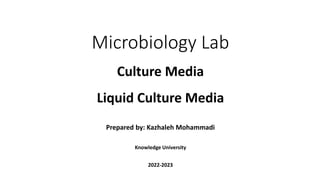
lec 8 liquid.pptx
- 1. Microbiology Lab Prepared by: Kazhaleh Mohammadi Knowledge University 2022-2023 Culture Media Liquid Culture Media
- 2. Types of Media in Microbiology • Many bacteria, yeasts, and molds that occur in nature can also be grown in the laboratory. In addition to water, the culture media used for this purpose have to contain the nutrients the microorganisms need for growth, in particular; • an energy source (typically sugars) • useable sources of the elements needed for biosynthesis and metabolism (especially nitrogen, sulfur, phosphorous)
- 3. Types of Culture Media • SOLID CULTURE MEDIA • SEMI-SOLID CULTURE MEDIA • LIQUID CULTURE MEDIA
- 4. Types of Culture Media Solid Media – contains 2% agar • Colony morphology, pigmentation, hemolysis. • Eg: Nutrient agar, Blood agar Semi-Solid media – 0.5% agar. • Eg: Motility medium Liquid Media – no agar. • For inoculum preparation, Blood culture, for the isolation of pathogens from a mixture. • Eg: Nutrient broth
- 5. LIQUID CULTURE MEDIA One method of bacterial culture is liquid culture, in which the desired bacteria are suspended in a liquid nutrient medium, such as Luria Broth, in an upright flask. This allows a scientist to grow up large amounts of bacteria for a variety of downstream applications. Liquid cultures are ideal for the preparation of an antimicrobial assay in which the experimenter inoculates liquid broth with bacteria and lets it grow overnight (they may use a shaker for uniform growth). Then they would take aliquots of the sample to test for the antimicrobial activity of a specific drug or protein (antimicrobial peptides).
- 6. Liquid media: These are available for use in test tubes, bottles, or flasks. Liquid media are sometimes referred to as “broths” (e.g nutrient broth). In a liquid medium, bacteria grow uniformly producing general turbidity. Certain aerobic bacteria and those containing fimbriae (Vibrio & Bacillus) are known to grow as a thin film called ‘surface pellicle’ on the surface of the undisturbed broth. Long chains of Streptococci when grown in liquid media tend to entangle and settle to the bottom forming granular deposits. Liquid media tend to be used when a large number of bacteria have to be grown. LIQUID CULTURE MEDIA
- 7. Liquid cultures are ideal for the preparation of an antimicrobial assay in which the experimenter inoculates liquid broth with bacteria and lets it grow overnight (they may use a shaker for uniform growth). Then they would take aliquots of the sample to test for the antimicrobial activity of a specific drug or protein (antimicrobial peptides). LIQUID CULTURE MEDIA
- 8. What is Nutrient Broth? Basically, the Nutrient Broth is the nutrient agar that lacks of the solidifying agent, agar powder. They remain in liquid form at room temperature and are usually used to maintain the stocks of microorganisms. In general, they are used to grow fastidious organisms. Also, you can enrich your nutrient broth with blood, serum, sugars… etc for special purposes.
- 10. Pre-sterilized glass or plastic graduated pipettes are used to transfer specific volumes of sterile liquids accurately. It is important that you learn how to use these tools correctly, since it may be necessary to transfer sterile and sometimes contaminated liquids among various bottles and tubes. LIQUID CULTURE MEDIA
- 11. How to prepare Nutrient Broth? 1) Add 13g of nutrient broth powder in 1L of distilled water. 2) Mix and dissolve them completely. 3) Pour them into the final containers (eg. conical flask) 4) Sterilize by autoclaving at 121°C for 15 minutes.
- 12. Transferring bacteria to a Nutrient Broth 1) Take up the inoculating loop by the handle, and hold the wire on the flame of a Bunsen burner until it glows red then cool it. 2) Pick up the solid culture with your left hand. Still holding the loop like a pencil, 3) Pass the neck of the open tube rapidly through the Bunsen flame two or three times (do not overheat; if it is glass, it could crack or burn you later; if it is plastic, it could melt). This flaming sterilizes the air in and around the mouth of the tube. 4) Insert the loop into the open plate. Touch the loop (not the handle) to culture.
- 13. 5) Insert the loop into the tube and down into the broth. Gently rub the loop against the wall of the tube (don't agitate or splash the broth), making sure the liquid does not touch the loop handle. 6) As you withdraw the loop, touch it to the inside wall of the tube (not the tube's mouth) to remove excess fluid from it. Pull it out without touching it, again flame the tube neck, replace the closure, and put the tube back in the rack. 7) Now carefully flame the loop, and be sure all of the wire is sterilized. When the wire has cooled, the loop can be placed on the bench top. 8) Label the tube you have just inoculated with your name and the date. Transferring bacteria to a Nutrient Broth
- 14. Some Tips To Remember • The pipette and the media are sterile; there should never be any direct contact with your hands, skin, or lab surfaces. • Caps or lids on tubes or bottles should never be set down on lab surfaces. • Tubes or bottles should be held at an angle during the transfer process, to minimize the potential for airborne contaminants to make their way into the opening. • Passing the opening of the tube or bottle briefly through a flame before and after the transfer process will discourage airborne contaminants from getting into the sterile liquid.